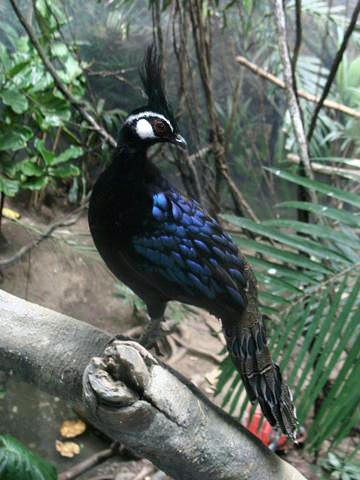- Polyplectron
Taxobox
name = Peacock-pheasants

image_width = 225px
image_caption = malePalawan Peacock-pheasant "Polyplectron napoleonis"
regnum =Animal ia
phylum =Chordata
classis =Aves
ordo =Galliformes
familia =Phasianidae
genus = "Polyplectron"
genus_authority = Temminck, 1813
synonyms ="Polyplectrum" ("lapsus")The
genus "Polyplectron" of the familyPhasianidae consist of seven peacock-pheasantspecies . The males have varying display plumage, while the females are colored far more inconspicuously.The systematics of the
genus are somewhat unclear. The species of "Polyplectron" evolved at some time between, roughly, theEarly Pliocene and theMiddle Pleistocene , or 5-1 mya [Themolecular clock used by Kimball "et al." (2001) is a very crude estimate based on an outdated model and uncalibrated byfossil evidence. Hence, their supposed divergence dates are as likely to be wrong as the assumption thatsea level changes were not a factor in the genus' radiation is unwarranted at this time.] .The morphologically somewhat aberrant "Polyplectron malacense" and its little-knownsister species "P. schleiermacheri" form a basal radiation around the southernSouth China Sea together with the striking "P. napoleonis", as is confirmed by comparison ofbiogeography andmtDNA cytochrome "b" andD-loop as well as the nuclearovomucoid intron G (Kimball "et al." 2001).The relationships of the other forms are more poorly understood. "P. germaini" and "P. bicalcaratum" are similar in morphology and are nearly
parapatric ; the molecular data suggests that the latter is asymplesiomorphy , but with not too high confidence. In any case, the brownish insular or peninsular species "chalcurum" and "inopinatum" do not seem to be derived from a single isolation event, and seem to have acquired the more subdued coloration independently. The trend in this genus to "lose", not to gain, pronouncedsexual dimorphism is better supported by biogeographical and molecular data than the alternate scenario.(Kimball "et al." 2001)Species
*
Palawan Peacock-pheasant , "Polyplectron napoleonis" - formerly "P. emphanum"
*Malayan Peacock-pheasant , "Polyplectron malacense"
*Bornean Peacock-pheasant , "Polyplectron schleiermacheri"
*Germain's Peacock-pheasant , "Polyplectron germaini"
*Grey Peacock-pheasant , "Polyplectron bicalcaratum"
*Bronze-tailed Peacock-pheasant , "Polyplectron chalcurum"
*Mountain Peacock-pheasant , "Polyplectron inopinatum"References
* Kimball, Rebecca T.; Braun, Edward L.; Ligon, J. David; Lucchini, Vittorio & Randi, Ettore (2001): A molecular phylogeny of the peacock-pheasants (Galliformes: "Polyplectron" spp.) indicates loss and reduction of ornamental traits and display behaviours. "Biol. J. Linn. Soc." 73(2): 187–198. [http://www.ingentaconnect.com/content/els/00244066/2001/00000073/00000002/art90536 HTML abstract]
Footnotes
Wikimedia Foundation. 2010.
